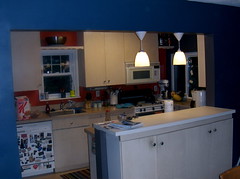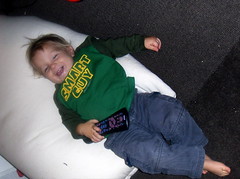two books about eating
Leaving Heathrow on Monday morning, I had breakfast at an Irish pub (what's wrong with a pint of bitter at 10am?) and ate what they called a "typical Irish breakfast": eggs, potatoes, bacon, and "black pudding." I had my suspicions about black pudding but tried it anyway; it was fairly innocuous, if a bit cloying. I was not pleased, then, to get on the airplane, start reading Zola's THE BELLY OF PARIS, and discover that a key ingredient is a whole lot of fresh pig blood. Ugh. I have been on a bit of a Zola kick over the past year, and after a long-standing debate within my wife's family about the proper pronunciation of the Parisian market Les Halles (lay all, or lays all?) I was thinking about Les Halles, and then discovered that Zola wrote a novel all about the giant 19th-century market. THE BELLY OF PARIS is, as the Sun and Moon edition jacket copy says, "little known in English." But Sun and Moon put out an edition in 1996, and Oxford is publishing it in the US this year.
Like many of Zola's novels, the plot isn't much; it's all about the immersion in the details of a group of people in a very particular milieu. At times the novel seems like a basic framework intended just to string together a bunch of set pieces about food. Zola revels in the different food stalls in the market, enumerating the various kinds of cherries or fish or sausages available. His descriptions go from savory to disgusting, precisely in the same way that eating far too much rich food goes. I don't think I'm going to ever forget the pages about the making of sausages, black puddings, and the like--I could smell the fat in the air and could only imagine--given how modern scrubbing techniques still can't get the grease smell out of fast-food joints--the smell of the small unventilated basement rooms in which the butcher boils fat. I wanted some very vivid, tactile, olfactorily unforgettable descriptions of the Paris markets circa 1860 (because I have become very interested in farmers markets today and have been to some huge comestible markets, in places like Oaxaca, that must be like what Les Halles was like back in the day.
I read THE BELLY OF PARIS on the way back from England, and on the way there I read another very similar (in subject-matter) book: Bill Buford's HEAT. I read Buford's amazing AMONG THE THUGS a year or so ago and was amazed--it's about a very smart writer--a guy who ended up being the fiction editor for the NEW YORKER and who founded GRANTA, for chrissake--who became so fascinated by the world of English soccer thugs that he joins them and even travels to international games to get involved in their riots. A real "new journalist," he gets far too involved in his subjects. HEAT is about his fascination with the celebrity chef Mario Batali and, ultimately, his quest to repeat, and even transcend, Batali's own training regimen. Unlike many big-time chefs, of course, Batali didn't train at a high-end place (CIA, Cordon Bleu), but rather at the most down-home kind of Italian trattoria. HEAT wavers between profiling Batali's life and strategy to start his own new kind of Italian place in New York, and Buford's own desire to learn what Mario does. Buford begins by working in Batali's kitchen at the great Babbo in Greenwich Village--and of course learning in the process the great traditions of the urban commercial kitchen, also elucidated well in Anthony Bourdain's KITCHEN CONFIDENTIAL. He then journeys to Italy to meet Batali's mentors, before coming to the realization that it's not enough to COOK the meat--you've got to butcher and cure it yourself--so he's off to the butt-end of Tuscany to learn that from the masters. The underlying theme of the book is one I'm increasingly drawn to: the disappearance of our relationship to the origins of our food. In THE OMNIVORE'S DILEMMA and FAST FOOD NATION the authors draw political conclusions from this; Buford is much more interested in the gastronomic and cultural ramifications. The most telling example he brings up is one that would be touch for any but a specialist to discern: there are cuts of meat typical in parts of Tuscany that just don't exist elsewhere, because the very ways that animals are butchered are rooted in place. At some level, this book is a lament for the rapid loss of those millions of local traditions that have determined how and what people eat. Culture, Buford says here, in a very literal sense begins with what we put in our mouths, and the complicated textures of world culture, he suggests, are quickly being flattened out.It's really a fantastic book, if characterized a bit too much by Tina Brown-era NEW YORKER fascination with celebrity.
Like many of Zola's novels, the plot isn't much; it's all about the immersion in the details of a group of people in a very particular milieu. At times the novel seems like a basic framework intended just to string together a bunch of set pieces about food. Zola revels in the different food stalls in the market, enumerating the various kinds of cherries or fish or sausages available. His descriptions go from savory to disgusting, precisely in the same way that eating far too much rich food goes. I don't think I'm going to ever forget the pages about the making of sausages, black puddings, and the like--I could smell the fat in the air and could only imagine--given how modern scrubbing techniques still can't get the grease smell out of fast-food joints--the smell of the small unventilated basement rooms in which the butcher boils fat. I wanted some very vivid, tactile, olfactorily unforgettable descriptions of the Paris markets circa 1860 (because I have become very interested in farmers markets today and have been to some huge comestible markets, in places like Oaxaca, that must be like what Les Halles was like back in the day.
I read THE BELLY OF PARIS on the way back from England, and on the way there I read another very similar (in subject-matter) book: Bill Buford's HEAT. I read Buford's amazing AMONG THE THUGS a year or so ago and was amazed--it's about a very smart writer--a guy who ended up being the fiction editor for the NEW YORKER and who founded GRANTA, for chrissake--who became so fascinated by the world of English soccer thugs that he joins them and even travels to international games to get involved in their riots. A real "new journalist," he gets far too involved in his subjects. HEAT is about his fascination with the celebrity chef Mario Batali and, ultimately, his quest to repeat, and even transcend, Batali's own training regimen. Unlike many big-time chefs, of course, Batali didn't train at a high-end place (CIA, Cordon Bleu), but rather at the most down-home kind of Italian trattoria. HEAT wavers between profiling Batali's life and strategy to start his own new kind of Italian place in New York, and Buford's own desire to learn what Mario does. Buford begins by working in Batali's kitchen at the great Babbo in Greenwich Village--and of course learning in the process the great traditions of the urban commercial kitchen, also elucidated well in Anthony Bourdain's KITCHEN CONFIDENTIAL. He then journeys to Italy to meet Batali's mentors, before coming to the realization that it's not enough to COOK the meat--you've got to butcher and cure it yourself--so he's off to the butt-end of Tuscany to learn that from the masters. The underlying theme of the book is one I'm increasingly drawn to: the disappearance of our relationship to the origins of our food. In THE OMNIVORE'S DILEMMA and FAST FOOD NATION the authors draw political conclusions from this; Buford is much more interested in the gastronomic and cultural ramifications. The most telling example he brings up is one that would be touch for any but a specialist to discern: there are cuts of meat typical in parts of Tuscany that just don't exist elsewhere, because the very ways that animals are butchered are rooted in place. At some level, this book is a lament for the rapid loss of those millions of local traditions that have determined how and what people eat. Culture, Buford says here, in a very literal sense begins with what we put in our mouths, and the complicated textures of world culture, he suggests, are quickly being flattened out.It's really a fantastic book, if characterized a bit too much by Tina Brown-era NEW YORKER fascination with celebrity.
Labels: books


